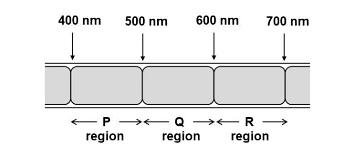The first step in dark reaction of photosynthesis is
- formation of ATP
- ionization of water
- attachment of $CO_2$ to a pentose sugar
- excitement of electron of chlorophyll by a photon of light
The Correct Option is C
Approach Solution - 1
Approach Solution -2
The dark reactions can occur in both the presence and absence of sunlight. These reactions are totally independent to the sun. It also involves the fixation of carbon dioxide, resulting in the formation of carbohydrates. Therefore this process is not directly depend on the presence of light, but it utilizes ATP and NADPH (assimilatory power) obtained as a result of light reactions for the reduction and fixation of carbon dioxide. The dark reaction is also known as the Blackman reaction, which is named after the scientist who reported it for the first time. It is the biochemical phase. In the Calvin cycle, the first product in the series of reactions is a 3-carbon compound (phosphoglyceric acid). This pathway is also known as the C3 cycle. This cycle is also called the Calvin-Benson-Bassham cycle. The primary acceptor of carbon dioxide in this cycle is ribulose 1, 5-bisphosphate (RuBP), which forms two molecules of 3-phosphoglycerate (3PGA). Rubio catalyzes this reaction. Hence, from the above information, we can say that the first step in the dark reaction of photosynthesis is the attachment of carbon dioxide to a pentose sugar.
Therefore, option C is the correct answer.
Top Questions on Photosynthesis in higher plants
- The net number of molecule(s) of NADH formed from one molecule of glucose in glycolysis under aerobic conditions is/are _______.
- IIT JAM BT - 2023
- Biology
- Photosynthesis in higher plants
- Different segments of a photosynthetic filamentous alga are exposed to different wavelengths of light as shown below. After a period of time, bacteria known to migrate towards high oxygen concentration, is spread on the surface of the alga. Which region(s) of the alga will have maximum bacterial congregation?

- IIT JAM BT - 2023
- Biology
- Photosynthesis in higher plants
- Which one of the following statements about photoproteins in plants is INCORRECT?
- IIT JAM BT - 2023
- Biology
- Photosynthesis in higher plants
How many ATP and NADPH2 are required for the synthesis of one molecule of Glucose during Calvin cycle?
- NEET (UG) - 2023
- Biology
- Photosynthesis in higher plants
The reaction centre PS II has an absorption maxima at
- NEET (UG) - 2023
- Biology
- Photosynthesis in higher plants
Questions Asked in UP CPMT exam
- The concepts of 'struggle for existence' and 'survival of the fittest' are essential parts of the evolutionary theory given by
- UP CPMT - 2015
- What Are The Evidences For Evolution?
- Which of the following is a gymnosperm in which vessels are found?
- UP CPMT - 2015
- Kingdom Plant
- If earth suddenly shrinks by one-third of its present radius, the acceleration due to gravity will be
- UP CPMT - 2015
- Gravitation
- If a wire is stretched to make it $0.1\%$ longer, its resistance will
- UP CPMT - 2015
- Current electricity
- Boiling point of chloroform was raised by $0.323 \,K$, when $0.5143\, g$ of anthracene was dissolved in its $35 \,g$. Molecular mass of anthracene is $(K_b$ for $CHCl_3 = 3.9 \,K \,kg\,, mol^{-1})$
- UP CPMT - 2015
- Solutions
Concepts Used:
Photosynthesis in Higher Plants
Processes Of Photosynthesis in Higher Plants:
Photosynthesis in higher plants involves the following processes:
- Light Reaction
- Dark Reaction
Light Reaction:
- This phenomenon occurs in the presence of light.
- The pigment absorbs light and produces energy in the form of ATP.
- The process involves- absorption of light, water splitting, the release of oxygen, and formation of ATP and NADPH.
Dark Reaction:
This process occurs in the absence of light in the stroma of the chloroplasts. The following cycles are involved in the process:
- Calvin Cycle (C3 Cycle)
- C4 Cycle (Hatch and Slack Pathway)



